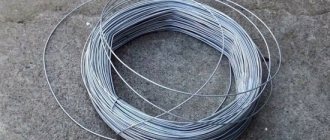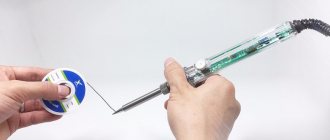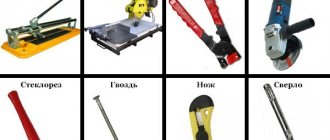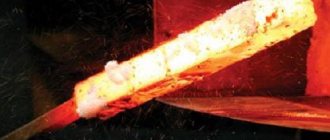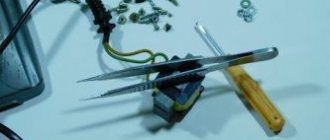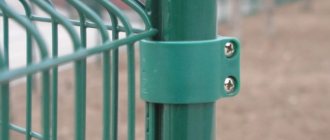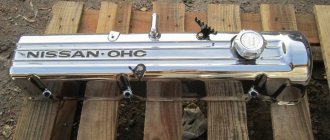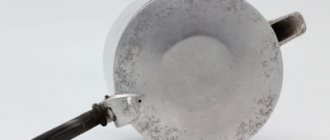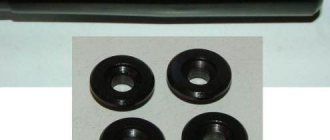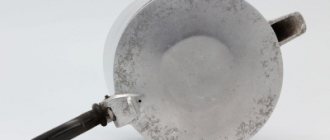Content:
- Variety of ways to cut metal
- Mechanical cutting of metal: how to cut iron, steel, copper
- Hand scissors
- Saws - this is what you can use to cut metal
- Angle grinders (angle grinders)
- Pipe cutters
- Wire cutters
- How to cut metal: a circular saw or a reciprocating saw
- Grinder and band saw
- Thermal methods
- Gas cutting
- Gas-electric technology
- Plasma technology
- Waterjet technology
- Guillotine
- How is injection cutting of thick metal performed?
- When arc cutting of thick metal is required
- Disadvantages of plasma technology
- Bend
- We break it down
- We use an electric jigsaw
- We use a multitool
- Professional ways
With the help of what tools and technologies is it easiest to separate a part from the whole workpiece? Let's consider how to cut metal, thin and thick, sheet and not, steel and iron. We will analyze the features of well-proven methods of influence so that you can be convinced that it is absolutely not necessary to use expensive equipment. Manual devices can also give the desired result and ensure the accuracy and precision of the operation, which in the future will make it possible to produce objects of the required shapes and sizes.
As a result, knowing all the options, you will be able to decide and choose the right one that is most suitable for your garage, cottage, backyard workshop, or even for production, if it is small-scale.
Multifunctional power tool
The renovator is now supplied by many leading manufacturers as the optimal tool for household use. With it, you can do all the household chores with one piece of equipment. This is a convenient, not heavy device with manual drive and access to the electrical network. There are battery-powered models, but they break down faster.
The essence of the device is a large number of attachments, one of which is designed for sawing metal parts. It can indeed help cut wire or thin sheets, but you should not expect high quality from a device for home use. Usually the golden rule applies here - quality is better than quantity of features.
Gas cutting
The procedure goes like this. An abrasive is something that can be used to cut metal . They cover the abrasive discs. But modern methods help supply air or other gas with such pressure that the sand particles contained in it produce an even cut. In this case, oxygen passes through the burner and is heated to such temperatures as to overcome the threshold of plastic deformation of the steel.
Variety of ways to cut metal
They are divided into two fundamentally different groups:
- Cold - separation is carried out due to the mechanical impact of a tool on the workpiece, the hardness of which is higher than that of the part.
- Hot - the process involves using a thermal effect: a gas (liquid or other substance) heated to a high temperature melts the material at the contact points.
The choice of a specific method depends on a number of specific factors:
- the structure and density of the surface being processed (for aluminum it is one, for an alloy based on it it is different);
- volume and efficiency of the work carried out;
- the dimensions to be achieved and the complexity of the final form;
- LxWxH of the resulting part;
- the budget you have.
Description and features of the process
Metal cutting is a technological process, the purpose of which is to divide a workpiece into separate parts or produce parts of various shapes. During machining, various milling and turning machines, as well as special metal-cutting equipment, can be used.
When carrying out the technological process under consideration, the following points are taken into account:
- Mechanical processing leads to heating of the material. Almost all metals react to heating in the same way - a change in the basic physical and mechanical properties occurs, the degree of ductility increases, and strength decreases. When it is necessary to obtain a high-quality cut, heating of the material structure is eliminated.
- Not all alloys can be processed without preheating. There are difficult-to-cut alloys, the cutting of which is possible only if the structure is preheated.
- When processing, attention is paid to such qualities as thermal conductivity, hardness and weldability.
Most often, cutting steel and other alloys occurs at the time of preparing raw materials for further processing, production of products, or, if necessary, changing the size and shape of finished products at the time of installation work. There are a huge number of cutting methods, each with its own specific properties.
Mechanical cutting of metal: how to cut iron, steel, copper
All cold methods are based on physical impact, without heating the contact point between the tool and the part.
This requires some effort from the performer, but any method turns out to be relatively economical to implement, provides fairly high accuracy and precision of the result, and allows you to achieve smooth edges. True, you can only separate a part from the whole workpiece in a straight line, this is a minus. So, what devices are usually used in this case?
Hand scissors
They differ from spline ones by the absence of an electric motor, and from guillotine ones by their operating principle. In fact, this is the simplest and most affordable option - the classic answer to the question of what is the best way to cut thin metal at home. Because they are always on sale, and at modest prices, it is not difficult to purchase them for any workshop.
With their help, it is quite easy to separate strips, working along the intended line, but for this their edges must be very sharply sharpened.
The following types are distinguished:
- finger;
- power;
- chairs;
- lever;
- curvilinear.
They differ from each other in the design and vector of the applied load.
In addition to manual ones, there are also the already mentioned splined ones, suitable for work in limited space, and guillotine ones, which impress with their “clean” result - there are almost no defects.
Saws - this is what you can use to cut metal
The obvious choice is a hacksaw.
With its help, you will, with physical effort, separate one part of the profile from another or create some kind of shaped element. It is more convenient if the one you choose has a sliding frame, this will allow you to place and use canvases of different lengths. It is important that the latter be hardened and have a hardness of 60–63 HRC, and also have a sufficient number of teeth of a suitable size – 16–18 per inch.
Angle grinders (angle grinders)
In other words, the well-known grinders equipped with a disc. They offer impressive performance and leave very little dross behind. Yes, their primary task is to clean surfaces from uneven surfaces, but they are also a very versatile tool: they can be used to cut metal quickly and easily, cutting out squares and strips from sheet blanks, creating reinforcement and shaped elements. After which any of these items can be sanded to a shine.
The most important advantage is that to perform various technological operations you only need to change consumables, which, in essence, are disks, with teeth or abrasive, of varying degrees of roughness. Yes, they are all washable, but buying new ones is not a problem. And you already have the machine itself, and it will last for many years, especially with careful care - a great option for a garage or personal workshop.
Pipe cutters
Here's what to cut metal and rolled products with a diameter of 0.25 to 4 inches. They provide higher productivity due to a design of 3 rollers: the first two are fixedly mounted on the device body, the third provides screw clamping. As a result, the separation of part of the part occurs in a matter of moments, without unnecessary effort on the part of the performer and perfectly smoothly.
Wire cutters
They are convenient when working with rods, rods, wires, even wires. Their edges can be end or side, and the nature of the separation depends on this. For “difficult cases”, such as reinforcement of considerable thickness or, conversely, small-sized fasteners, there are bolt cutters. Due to the double-lever design, they allow you to create a serious load on the workpiece without exerting enormous physical effort.
Metal cutting tools
You can also cut metal at home - for this purpose, mechanical devices such as scissors and saws of various types are used.
Hand scissors
Suitable if the metal thickness does not exceed 3 mm. Hand shears are one of the most popular tools for household metal processing. However, they come in several types:
- for straight cutting;
- for curved cutting;
- finger - for cutting along a complex trajectory;
- scissors with one movable blade.
Saws
Saws for metal also come in different varieties. Each has its own advantages and disadvantages. Metal cutting is performed with a saw of one of the following types:
- manual;
- disk;
- tape;
- end;
- pendulum;
- circular.
You should choose a saw taking into account the specific task and characteristics of the material. For example, a miter saw allows you to cut at an angle, while a circular saw is great for cutting thin sheets of metal.
angle grinder
This metal cutting tool is commonly known as a grinder. It is convenient to use due to its light weight and versatility. Replaceable discs allow processing of metal of different thicknesses. In addition, the grinder can not only cut, but also grind and polish the surface. Thanks to its convenience and wide functionality, an angle grinder is considered the optimal tool for cutting metal in everyday life.
The specialists of the Cherepovets Metal Structures Plant have many years of experience working with a variety of materials. For industrial cutting of metals, we use modern equipment and certified raw materials, which allows us to guarantee high quality metal structures.
How to cut metal: a circular saw or a reciprocating saw
Tools from this category are divided into 2 subgroups:
- Reciprocating saws - act in the same way as jigsaws; their main element is a replaceable blade of 100–350 mm, which performs reciprocating movements during operation (it should be narrower, the smaller the radius of the workpiece). They are powered either from a centralized network or from a battery, and this is their plus and minus at the same time. They are portable, but you have to use electricity to use them, which is an additional expense. To cope with any of them requires skill and a good eye.
- Disc ones are easier to operate, and this is a powerful argument when you decide what is better for sawing metal. Their cutting elements are made of hard alloys, which means they are durable. Another advantage is the minimum amount of chips and the ability to make even narrow grooves. The wider the diameter of the circle, the greater the versatility. True, they are relatively expensive, have impressive dimensions and are heavy, this is a drawback.
Processing steel products at home
The choice of one or another method for cutting steel is influenced by the thickness of the material, the possibility of exposure to electricity, as well as the amount of work. After analyzing all the characteristics, a decision is made to use a specific machine.
There are several ways to cut steel pipes, angles, bars, rods or strips. Let's take a closer look at each of them.
- Vise and hacksaw for metal.
These devices are used for small volumes of work and in cases where the thickness of the material is small.
VT-metall offers services:
Of course, you can saw off a metal rod with a diameter of 5–7 cm, or a corner with a cross-sectional size of 0.5 cm and an area of 50x50 cm. But the result obtained will not be comparable to the effort and time expended - one cutting will take several hours.
If the craftsman does not have a hacksaw on hand, then it can be replaced with a regular file. It is suitable for small jobs, for example, for filing a thin bar before a flexible one.
- Electric jigsaw and metal file.
A jigsaw is used for thin metals (1-2 mm in cross-section), as well as for small corners, rods, etc. It can also be used to perform shaped cutting elements.
This device is not very productive, but it gives accurate results. When working with thick rolled products, it is recommended to pre-lubricate the file and the workpiece with grease.
- Metal scissors.
This method of cutting steel is suitable for processing thin and soft sheets.
Using metal scissors you can cut a plate up to 2-3 mm thick. There is a special technique - you need to build a lever. To do this, one handle is fixed in a vice, and a long pipe is put on the other. A sheet of steel is placed on the blade of the scissors, force is applied to the pipe-handle and cutting occurs. The power of such a “installation” will depend on the strength of the master himself.
You can also use a hammer to make the scissors more effective. However, this cutting method is suitable only in cases where the accuracy and evenness of the edge is not of great importance.
There are many varieties of this type of tool on the modern market. There are even units with electric drive. However, this modification bears little resemblance to the scissors themselves. You could say this is a completely different way of cutting. We will talk about its features below.
- Bulgarian.
This tool is an angle grinder that acts on the material using special cutters: cutting, grinding, abrasive, etc. The metal is cut here as follows: first it is shaped with a cutting wheel, and then the cut site is processed with a grinding disc.
Today, the grinder is considered the most effective way to cut steel among household systems. A skilled craftsman can easily handle both rolled metal and corners, rods and even pipes.
- Reciprocating saw.
It is also called an electric hacksaw. It appeared on the market relatively recently, but has already shown its best side: this tool is used when working with cardboard, wood, plastic and soft metals (aluminum, stainless steel), and aerated concrete. According to the cutting mechanism, it resembles a jigsaw, but, unlike it, you can change the blades depending on the tasks. In addition, such a system is more mobile, does not require support and is distinguished by its power - even metal pipes with a diameter of more than 2-3 cm can be cut.
- Pipe cutter
It is most often used in garage workshops. The mechanism of action can be based on cutter rollers or special scissors. This is an excellent way to cut steel pipes, even those with a diameter of 10 cm or more.
Its significant advantage is the high quality of cuts. The disadvantages include a narrow scope - this tool is used only for cutting pipes.
- Electric metal shears.
They can be found in the arsenal of both a garage mechanic and an experienced specialist. Models of this device are also divided into household and professional. The former have a more affordable price and can handle sheets up to 2 mm thick. The latter are capable of processing a profile with a cross-section of 3 mm or more, but this option is more expensive.
Grinder and band saw
The first is the most common model of angle grinder, and we, in fact, have already examined it.
Therefore, let's pay attention to the second one. This is equipment that allows you not only to position the workpiece correctly and safely, but also to move it in any desired direction. Precise positioning ensures a perfect edge during processing and minimizes material loss. Although it is not suitable for large-sized parts, it is the only negative.
The most modern steel cutting methods
Waterjet cutting is considered the most breakthrough method of steel processing.
Dissection occurs under the influence of a directed jet of water emerging from a nozzle under high pressure. It is capable of piercing sheets up to 300 mm thick.
The centerpiece of a waterjet cutting machine is a heavy-duty pump. In experimental samples, it supplies water at pressures of up to 6,000 bar. Then, passing through a ruby, diamond or sapphire nozzle, the thickness of which is only 0.1 mm, the flow intensity increases several times. As a result, the jet acquires a speed three times the speed of sound. This unit can process almost all types of material, including steel.
The performance of a device of this type cannot but amaze. So, with a stainless steel sheet 10 cm thick, it is capable of working at a speed of 22 mm/min, and if the thickness is only 1 mm, then this figure will reach 2,700 mm/min. When processing glass, a waterjet machine can reach speeds of up to 11,000 mm/min.
Methods for cutting steel using a waterjet may vary depending on the characteristics of the workpiece. Thus, thin and soft materials are cut with a stream of clean water, and when working with hard compounds, garnet sand is added to it (to increase abrasiveness). Thus, the cutwater can cope with source material of any strength.
We recommend articles on metalworking
- Steel grades: classification and interpretation
- Aluminum grades and areas of their application
- Defects in metal products: causes and search methods
To identify “competitors” of waterjet cutting, a number of tests were carried out abroad. It turned out that the laser has the closest indicators to it. During the experiment, both types of cutters processed stacks of metal plates (each of them was 0.3 mm thick). As a result, it was found that for rolling up to 6 mm it is more effective to use a laser - under these conditions it is faster and more energy efficient. When working with material over 6 mm, waterjet cutting works best.
The undoubted advantage of the waterjet method is that when working with the workpiece it does not heat up at all. That is, the material is not subjected to thermal effects and, therefore, does not deform or change its strength characteristics. Thanks to the targeted flow of water, the edges are even and smooth and do not require final sanding.
If we talk about versatility of use, the laser cannot be used with all metals. For example, this cutting method is not suitable for steel due to the strong reflection of the beam. This does not interfere with the water jet cutter. However, it should not be used on materials that are not resistant to getting wet (to avoid corrosion).
Another advantage of waterjet cutting steel is that the water “blade” is as thin as a hair. This ensures minimal loss of material during work.
Thermal methods
An oxygen flame heated to a very high temperature, a stream of electrically charged gas, or even a jet of plasma - this is what can be used to cut iron, steel or any other metal. There are several methods, each with its own characteristics, but they all have certain advantages:
- The thickness of the workpiece does not play a special role - the passage will be almost instantaneous.
- Any material can be used, even very hard ones, and alloys are no exception.
- The technologies are highly scalable – both for small-scale and large-scale production.
It is in this area that experiments and research are being carried out today. If mechanical methods are considered a classic of manual labor, then thermal methods are promising from the point of view of automating the processes of producing parts. Therefore, let’s take a closer look at their varieties.
Gas cutting
In this case, the flame is brought to a high temperature without the use of electricity. There are three options for a medium that acts as an instrument:
- Pure oxygen - separation is carried out due to the influence of its heated jet.
- With the addition of flux - a powder that immediately has a triple effect: chemical, abrasive and thermal. Essentially, it is a catalyst that speeds up the process and produces a cleaner weld.
- Using a “spear” - a special tube that burns when working gas is blown through it; This minimizes the amount of scale.
The advantage of the method is its relatively low cost. And this is also a simple answer to the question of how to cut thick metal, but the method also has a lot of disadvantages. Among its disadvantages:
- significant consumption of material;
- low degree of accuracy;
- the need for subsequent cleaning of the edges;
- deformation of contact surfaces;
- general slowness of the process.
It is not surprising that experts sought to find a more advanced solution. Let's look at the results of their research right now.
Gas-electric technology
Here, current is already used - it heats the jet, which melts the material and carries away waste particles with its flow. One of two media options is used:
- compressed air is what is used to cut thick metal in most cases; and it also blows out the residues from the melting zone, which is convenient;
- oxygen - enters gradually but steadily, forms a stable arc that separates part of the workpiece from the whole and at the same time removes oxides.
Most often, this method is used when it is necessary to eliminate defects after welding. True, when the electrodes burn, the surface is often excessively saturated with carbon and it is necessary to additionally remove it, otherwise it will negatively affect the subsequent service life of the part. Noticing this phenomenon, experts tried to find an even more perfect solution, and achieved success.
Plasma technology
Ionized gas is the tool used to cut metal today (if we are not talking about hand tools).
It is heated to the state of a liquid and viscous stream, with the help of which the material is melted. Thus, it is not difficult to make an object of any shape, even curly or complex, with high precision and quickly. The benefits are as follows:
- Processing is carried out quickly, which allows you to achieve good labor productivity.
- Universal application - suitable for both hard cast iron and soft aluminum.
- Excellent quality of the final seams - no stripping or sanding required.
- Environmental friendliness and overall safety of operations.
Yes, tools are used for manual cutting of metal, and plasma is only applicable in production. Yes, it has certain disadvantages, but in the workshop, with regular and, especially, large-scale production, their influence is minimized. It is no coincidence that it is considered the most promising.
There are other methods, less common, but also interesting and worthy of attention.
Waterjet technology
Water saturated with solid particles (usually fine sand) is supplied to the line of the intended edge under pressure and a thin stream. Due to targeted action, this liquid separates the required part from the whole workpiece.
It has been successfully used since the mid-60s - it shows how you can cut sheet and thick metal, which is even more important. Over the past half century, the method has been improved to the limit, although in terms of accuracy and speed of obtaining results it is still somewhat inferior to advanced hot methods.
Guillotine
The material is placed between two knives, one of which is fixed to the frame at a certain angle, and the second is movable: it falls on the first and, due to the impact, separates the desired strip, segment, section from the part. Accuracy of fixation is ensured by the clamping system, as well as the back stop. To prevent the blades from hitting each other (which can lead to dullness and premature wear), there is a gap between them, but it should not be more than 3 degrees, otherwise the final edge risks becoming cone-shaped or wrinkled.
Among other disadvantages it is worth noting:
- bends;
- twisting;
- saber-shaped
But if the sheet is 3–5 mm, these defects can be avoided.
How is injection cutting of thick metal performed?
It is carried out with a special burner, the power of which is selected based on the thickness of the material:
- at 5–100 mm it is small;
- at 8–200 – average;
- at 10–300 – high.
The mouthpiece is subjected to the greatest temperature loads, therefore, according to GOST 5191–79E, it must be made of bronze, be replaceable, multi-nozzle and of a suitable size (from zero to six); There are non-separable and composite varieties.
Method 6. Cutting metal with a grinder
An angle grinder is an angle grinder on which various grinding, abrasive, and cutting wheels are installed. A special cutting disc is used for cutting metals. After cutting, the cut area is treated with a grinding disc.
A grinder today is perhaps the most productive tool for non-professional metal cutting. It makes it quite easy to cut both pipes, rods, corners, and (with some training) sheets of metal. See also more details about the types of working discs for grinders.
When is arc cutting of thick metal required?
In essence, it comes down to melting the desired area. Relevant in the case of crowbar and sprues. This method is suitable if:
- There are no strict requirements for the final quality; uneven edges are acceptable;
- in the future, before welding, mechanical processing will also be performed;
- other equipment is missing or its use is impractical.
Here it is important to choose the right electrodes and current strength - according to the dimensions of the part. For workpieces 5–50 mm in size, 300–400 A and rods with a diameter of 4–5 mm are enough. It is necessary that the filler rods are coated with oxides for gas formation and magnesium ore - this will improve the cleanliness of the weld.
Disadvantages of plasma technology
Speaking about how to quickly cut metal in production conditions, we immediately recall this method, but it is not without its drawbacks, and these are:
- Expensive and complex equipment that requires regular maintenance.
- Difficulties in processing large-sized workpieces.
- The angle of deviation of the flow from the perpendicular is limited.
- The machine makes a lot of noise during the process.
The main point is that you cannot buy such equipment for a garage, country house or personal workshop. It is not profitable to solve one-time problems with its help. It is applicable only in workshops where the production of similar parts is on stream. This means it makes sense to consider more classic manual methods.
DIY ways to cut a rail
How to cut a rail at home or in a garage, what tools are suitable, what are the advantages of one or another method, read more carefully below.
Railway track service involves cutting out worn sections of rails using special equipment. In this material we will talk about how to cut a rail at home (or garage), which tools are more effective, how to act in each case and what are the advantages of one or another method.
We use an electric jigsaw
Here is a good option on how to cut metal at home, with high accuracy and without serious physical effort. With the help of this device it will not be difficult to even cut out some kind of shape, not to mention separating a piece of pipe or corner. The only negative is that this is a relatively slow process, although with the same hacksaw you will spend longer and spend more effort. Well, some energy consumption is also implied, although the amount should not be serious.
Method 5 Cutting with metal scissors
This method is suitable for cutting thin sheets of metal (preferably soft).
There is a trick that allows you to use scissors to cut an iron sheet 2-3 millimeters thick (depending on the strength of the cutter). We fix the scissors in a vice with one handle, and put a piece of pipe on the other (it should be longer than the handle itself). We get a lever and, as a result, a fairly powerful machine for cutting metals. We feed the iron or steel sheet onto the scissors, press hard on the pipe and... cut the metal.
Another way to increase the strength of the scissors is, again, using a hammer. It is worth noting that all this will most likely lead to a deterioration in the accuracy and evenness of the cut.
By the way, modern metal scissors are quite diverse in appearance and design, among them there are also electric scissors (however, they no longer resemble scissors in their appearance and in general this, one might say, is another way of cutting metal, about which see below).
Professional ways
This category includes processing on plasma torches, the use of lasers in galvanic installations, multifunctional machines and other specialized equipment.
The point is that you do not solve the problem yourself, but entrust it to a company for which this is a specialized service, and it makes the required number of parts within the specified time frame and is responsible for the quality, accuracy, and cleanliness of the seams. sells band saw machines, to clarify the information you are interested in, please contact our managers at the contact numbers listed on the page. They will answer all your questions. So, you have found out what tool is used when cutting metal at home, what is better to cut - gas or plasma technology and much more. We hope that now it will be easier for you to choose a method for processing workpieces.
Method 10. Cutting with electric metal scissors
Electric shears are an excellent tool for cutting sheet metal, used by both professionals and amateurs. Relatively inexpensive models, for example, the Interskol brand, will help cut sheets up to 2 millimeters thick. More powerful professional versions can handle metal up to 3 mm thick or more.
Metal shears will be extremely useful for those who cut metal tiles, corrugated sheets, etc. After all, alternative cutting with a grinder, even using a special metal circle, spoils the protective layer of the metal tile. And scissors allow you to make a neat cut without affecting the protection of the metal.
Possible methods of cutting rails
Despite the apparent complexity of the operation, dividing a metal element into small sections is not difficult. To do this, you can use one of the following devices:
- sewing needle;
- chisel;
- hacksaw (metal saw);
- grinder;
- rail cutter.
Each method is complicated in its own way, but the expected result (the rail cut into pieces) will be obtained. Now - in detail about each technique.
Cutting with a sewing needle
- the edges of the rail are installed on two supports with the base down;
- a thick sewing needle is placed perpendicular to the product at the intended fracture site;
- a sledgehammer makes a strong and precise blow to the place where the needle is attached, as a result of which the rail is cut in half.
- rapidity;
- minimum of available means;
- low risk of injury;
- the ability to do the work alone.
- experience is required - it’s not easy to hit the right spot accurately;
- the cutting line (cut) sometimes turns out crooked;
- it is necessary to strike only one precise blow; With several unsuccessful attempts, the integrity of the canvas will be compromised.
Is there a technology for cutting concrete without noise and dust?
When thinking about how to cut concrete, you need to take care of reducing the amount of dust that inevitably appears during the work process. In certain cases, nothing can be done and you have to work in difficult conditions, but in others it is quite possible to remove dust. The main thing is not to violate safety requirements and use proven methods.
Concrete cutting is a targeted mechanical impact on a monolith using rotating parts of a tool. Cutting is not accompanied by impact noise, but always involves noise from the electric motor driving the tool and the operation of its moving parts, which cut a groove in the stone or cut reinforcement, cut into pieces, etc.
Different methods are used for cutting concrete - manual, machine, wet and dry. The first two are determined by the type of tool chosen; the wet method involves the action of water on the cutting part and on the concrete surface itself; the dry method does not use water supply. Regardless of the cutting method chosen, the amount of dust accompanying the process is always quite large.
READ How to Lubricate the Bosch Grinder Gearbox
The most common methods for cutting concrete are:
- Diamond cutting of partitions and walls with hand tools (grinder and others).
- Diamond cutting using a stationary wall saw.
- Diamond cutting with seam cutters.
- Used for cutting rope.
When using a hand tool (most often a grinder ), you can connect a construction vacuum cleaner to it, which will suck in almost all the dust that appears during the cutting process. If there is no way to connect the tool to a vacuum cleaner, you can do everything yourself.
What you will need to create an adapter for a construction vacuum cleaner:
- Sewage outlet made of polypropylene with a diameter of 50 millimeters, at 45 degrees.
- Reinforced tape (more reliable).
- High quality masking tape.
The process of creating a vacuum cleaner attachment for dust removal:
- Place the grinder as stably as possible on the table or floor so that it lies upside down parallel to the plane of the base.
- Take the outlet with pliers or a clamp, turn on the grinder and “cut” the pipe along the body, 3 centimeters under the tool casing.
- Using reinforced tape, tape the outlet very tightly and tightly to the body of the angle grinder, going slightly into the saw blade (a few centimeters). The fixation of the pipe must be reliable so that it is attached motionlessly.
- Cover the open side of the casing with masking tape, thus connecting it to the outlet. Then you can connect a construction vacuum cleaner and remove dust while working.
This system does not imply any design changes in the tool, but before using it, it is advisable to consult with a representative of the manufacturer about the possibility of making modifications.
How to cut a balloon safely
Since the gas cylinder is explosive, if it is cut, there is a high chance that it may explode. The sawing procedure must be done with great care and certain requirements.
Since the vessel is designed to transport liquefied gas, the remainder of its contents is a liquid called condensate. This substance has a specific odor and a high degree of flammability. Therefore, you can’t just start cutting the container with a grinder.
First you need to remove the condensate, and to do this you need to get rid of the remaining gas in the cylinder.
In this position, the remaining gas is drained from the condensate cylinder
Important! The procedure for pouring out condensate should not be carried out at home, but choose a place in advance where there will be no people. First, you need to dig a hole in the ground to the depth of one spade bayonet. After that, pour out the condensate and set it on fire, moving away to a safe distance with the cylinder. After the burning is over, the hole needs to be buried.
During long-term operation, the gas that is transported in the container eats into the walls, so even after draining the condensate, cutting it is prohibited. It must be washed with running water and detergents. But, even after such a technique, the probability of fire is very high.
To start cutting a vessel, it is necessary to build a system for constantly supplying water to it, and begin work only after the container is filled with water.
READ How to Cut Plywood Without a Saw
Cutting a gas receiver
After the vessel is well washed, you can start cutting. This stage must also be carried out with water, since the cylinder still contains remnants of condensate absorbed into the walls. To do this, fill the container completely with water. Cutting is carried out in two positions:
- Cutting horizontally
Allows you to cut parts of the vessel according to pre-made markings, which are made using string and chalk. This method is convenient because when cutting, the balloon is easy to roll, thereby preventing the liquid inside from leaking out for the maximum amount of time.
Cutting a container horizontally
- Vertical cutting
Also often used in such works. To do this, the vessel is filled with water and a cut is made in the place where the cut will be made. After which the grinder is removed.
It is necessary to wait until the excess water drains down to the cutting level. After which an incision is made along the entire diameter of the vessel. This method is convenient in that you need to move independently as the cut progresses, and the vessel is securely fastened, as it will be filled with water.
Important! The choice of cutting position depends on how the operation will be carried out in the future, that is, how the vessel lid will be cut.
